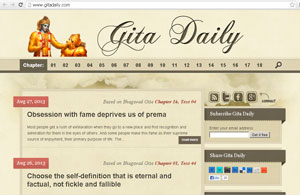
Happiness (Photo credit: Wikipedia)
Anyone can be happy in their life. It is the inalienable right of every living entity to be surrounded by unmitigated happiness. But practically no one realizes this right, because practically everyone looks for happiness in external objects and situations, or even if they look inward, they retain a selfish subjective viewpoint.
Happiness is actually part of the constitutional nature of what you really are.
To achieve happiness, the key is to come into harmony with what you really are.
So we have to make efforts to de-condition ourselves from the misconceptions of identity that are currently so deeply ingrained in us. It can start by trying to deprogram yourself from seeing yourself as some specific, temporary bodily, corporeal thing – a body of a particular age, gender, nationality, race, size, etc. Then, as these misconceptions start to dissolve you can begin to look inward more clearly and discern your true self more carefully, from amidst all your inner thoughts and feelings.
You will, if your introspection is clear, experience directly that you are a being with undeniable reality, and undeniable awareness. Then you will also notice that you are aware of conditions that exist outside yourself. When you actually taste the reality of perceiving this essence of who or what you are, you will intuitively realize that your undeniable awareness of reality reveals beyond a shadow of a doubt that you are an integral part of some great whole.
You will directly percieve that within yourself there is not only reality and cognition, there is also a latent pool of happiness. But you will immediately note that the happiness there is a dynamic energy that seeks to flow in a circuit from within the being out to the whole and back again.
This circuit is the experience of deep, exhilarating happiness that every one of us hankers after all the time. You will need to carefully contemplate upon the nature of this circuit if you will hope to realize deep contact with it, and thus become truly, deeply, profoundly happy.
If you give a good effort to this task, you’ll note that the nature of the circuit is loving. The energy of happiness that wants to flow out towards the whole to nourish the whole is the essence of pure love. This pure love is the soul of happiness. Then you will begin to realize that you are not just an abstract energy, you are a distinct personal entity and the supreme whole as well is also a personal entity. At this point you will begin to tangibly realize more specific details about the nature of your specific relationship with the whole, and the exact delightful manners in which your inherent pool of loving happiness will flow out to the whole.
The more you dedicate yourself to this effort to enter within your true self, the more you will find yourself peaceful, satisfied, even delighted and really happy – regardless of the ups and downs and ins and outs of the impossible to control victories and defeats constantly transpiring on the external stage of the projected world of time and matter.
There are practical paths laid out to help persons like us on our inward odyssey. The Hare Krishna mahamantra is an extremely direct and powerful tool for linking the true self with the whole through the circuit of pure love. The word “hare” establish the energy of bliss-giving love within the soul, and the words “krishna” and “rama” direct that energy towards the Whole Person. Thus the mantra itself is a meditation upon establishing the blissful divine connection between the soul and the whole.
The complete mantra is:
Hare Krishna, Hare Krishna, Krishna Krishna, Hare Hare.
Hare Rama, Hare Rama, Rama Rama, Hare Hare.
There are no rules set in stone regarding how to meditate using this mantra, but it is quite effective to set aside a certain block of time every day to softly but audibly pronounce the mantra, concentrating upon its significance and meaning. One can use beads or other means to count off a certain amount of mantras – if you want to introduce a more serious, more disciplined approach to your endeavor.
The mantra can also be utilized with large groups of people by singing it with musical accompaniment.
Sincere use of this mantra results in profound joy and happiness, for anyone.


 Download Srila Prabhupada Vyasa Puja Offerings 2013 as a PDF of ePub file Read more ›
Download Srila Prabhupada Vyasa Puja Offerings 2013 as a PDF of ePub file Read more ›  Download Srila Prabhupada Vyasa Puja Offerings 2013 as a PDF of ePub file Read more ›
Download Srila Prabhupada Vyasa Puja Offerings 2013 as a PDF of ePub file Read more ›  Srila Prabhupada: I was very naughty when I was a boy. I would break anything. When I was angry, I would break the glass hookah pipes, which my father kept to offer to guests. Once my mother was trying to bathe me, and I refused and knocked my head on the ground, and blood came out. They came running and said, “What are you doing? You shall kill the child.”
Srila Prabhupada: I was very naughty when I was a boy. I would break anything. When I was angry, I would break the glass hookah pipes, which my father kept to offer to guests. Once my mother was trying to bathe me, and I refused and knocked my head on the ground, and blood came out. They came running and said, “What are you doing? You shall kill the child.”  168 paintings: Srila Prabhupada's life in cartoons
168 paintings: Srila Prabhupada's life in cartoons 
 Janmastami media from facebook
Janmastami media from facebook  The large American Elm tree near the curved row of benches close to the center of the park was the site of the birth of the Hare Krishna movement in the United States in 1966
The large American Elm tree near the curved row of benches close to the center of the park was the site of the birth of the Hare Krishna movement in the United States in 1966  During the period of Lord Krsna's appearance, the killing of asuras or nonbelievers such as Kamsa and Jarasandha was done by Visnu, who was within the person of Sri Krsna
During the period of Lord Krsna's appearance, the killing of asuras or nonbelievers such as Kamsa and Jarasandha was done by Visnu, who was within the person of Sri Krsna  For the first time in history, a unique Ratha Yatra procession was held inside the campus of Delhi Technological University, organized jointly by Bhaktivedanta Institute, Kolkata(BI) and Delhi Technological University(DTU)
For the first time in history, a unique Ratha Yatra procession was held inside the campus of Delhi Technological University, organized jointly by Bhaktivedanta Institute, Kolkata(BI) and Delhi Technological University(DTU)  96 photos: Road Trip to Italian Yatra
96 photos: Road Trip to Italian Yatra  We are looking for two persons to fill the services of a cook and a pujari for our beloved full-sized Sri Sri Gaura Nitai deities. Experience is valuable but not required. Accommodation and other facilities will be provided
We are looking for two persons to fill the services of a cook and a pujari for our beloved full-sized Sri Sri Gaura Nitai deities. Experience is valuable but not required. Accommodation and other facilities will be provided  We are looking for four pujaris, male and/or female for the different areas of pujari service to Sri Sri Radha Paris Ishwara, Jaganath Baladev and Subadra, and Nitai Saci Suta
We are looking for four pujaris, male and/or female for the different areas of pujari service to Sri Sri Radha Paris Ishwara, Jaganath Baladev and Subadra, and Nitai Saci Suta  (From the Italian newsletter "Movimento ISKCON") His Grace Anuttama prabhu – international ISKCON Communications director and current GBC vice-chairman – with great sensitivity and in his very own humorous way held a long seminar from July 8 to 11 in Villa Vrindavana, one of the finest property of ISKCON in Italy
(From the Italian newsletter "Movimento ISKCON") His Grace Anuttama prabhu – international ISKCON Communications director and current GBC vice-chairman – with great sensitivity and in his very own humorous way held a long seminar from July 8 to 11 in Villa Vrindavana, one of the finest property of ISKCON in Italy 








 Mesmerising Janmashthami Trailer by Iskcon Belarus.
Credit: Bhakta Alexander Pashuk - the author, his wife Julia Bhaktin Pashuk - sound, Pandu das - the text, the idea of Vaikuntha Priya dd - Pictures, information and support.
Mesmerising Janmashthami Trailer by Iskcon Belarus.
Credit: Bhakta Alexander Pashuk - the author, his wife Julia Bhaktin Pashuk - sound, Pandu das - the text, the idea of Vaikuntha Priya dd - Pictures, information and support. 
 Panoramic Magazine with most worldwide Janmastami events from all over the globe
Panoramic Magazine with most worldwide Janmastami events from all over the globe